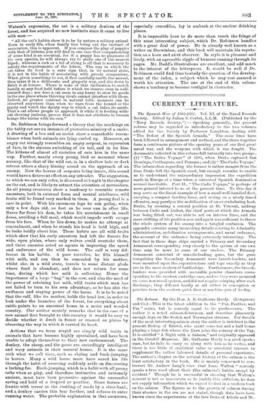The Salmon. By the Hon. A. E. Gathorne Hardy. (Longmans
and Co.)—This is the latest addition to the " Fur, Feather, and Fin " series, but is scarcely equal to its predecessors. The author is a noted salmon-fisherman, and describes pleasantly enough days on the Scotch and Norwegian streams. For details of the most interesting salmon story the author is indebted to the present Bishop of Bristol, who spent some ten and a half hours playing a huge fish where the Earn joins the estuary of the Tay. It is entitled " A Night with a Salmon," and originally appeared in the Cornhill Magazine. Mr. Gathorne Hardy is a good sports- man, but he fails to carry us along with him as he writes, and there is too little of statistical value or anecdotal interest to supplement the rather laboured details of personal experience. The author's chapter on the natural history of the salmon is the least satisfactory in the book. He is mainly concerned to con- trovert Mr. Andrew Lang's view that Isaac Walton " scarcely speaks a true word about their (the salmons') habits except by accident." Though he is successful in showing that Walton's account is not so inaccurate as to justify this criticism, he does not supply information which we expect to find in a modern book on the salmon. The figures as to the growth of salmon during their absence in the sea are not stated, though data have been known since the experiments of the late Duke of Athole and Mr.
Young of Invershin. To account for the general absence of food in the stomachs of salmon caught in fresh water, he revives the theory that the salmon when hooked at once disgorges its last meal ; and quotes the case of a fish of 28 lb. hooked through both lips by Mr. Naylor in such a way that the mouth was closed. A partly digested parr fell from this salmon's mouth. Other fish, including codling and whiting, trout and grayling, sometimes disgorge their food when caught. Charles Kingsley mentions this in one of his letters. But the report of the Fishery Board of Scotland, just issued, is conclusive. The salmon stores up enough energy in the sea to carry it over the period of reproduc- tion and the labour of ascending the river. The digestive organs, both stomach and intestines, are "out of gear" and atrophied while the fish is on its way to the spawning beds. The author thinks that their readiness to take the salmon-fly is because they mistake it for a prawn, as the shape of a fly in the water resembles that of a small crustacean. It is much more probable that the salmon mistakes it for one of the brilliantly coloured larval forms of certain rock-haunting fish. A useful, record of verified weights of big fish is inserted. Mr. Innes Shand discourses at needless length on the cookery of the salmon, and Mr. C. D. Pennant writes a useful chapter on "The Law as to Salmon-Fishing." The illustrations, except that of a leaping salmon on the title page, are mediocre.



















































 Previous page
Previous page